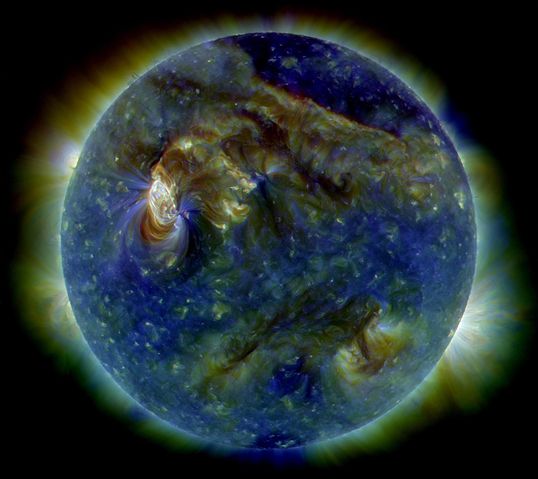| Description |
English: On August 1, 2010, almost the entire Earth-facing side of the sun erupted in a tumult of activity. This image from the Solar Dynamics Observatory of the news-making solar event on August 1 shows the C3-class solar flare (white area on upper left), a solar tsunami (wave-like structure, upper right), multiple filaments of magnetism lifting off the stellar surface, large-scale shaking of the solar corona, radio bursts, a coronal mass ejection and more.
This multi-wavelength extreme ultraviolet snapshot from the Solar Dynamics Observatory shows the sun's northern hemisphere in mid-eruption. Different colors in the image represent different gas temperatures. As of August 21, Earth's magnetic field is still reverberating from the solar flare impact on August 3, 2010, which sparked aurorae as far south as Wisconsin and Iowa in the United States. Analysts believe a second solar flare is following behind the first flare and could re-energize the fading geomagnetic storm and spark a new round of Northern Lights.
Deutsch: Am 1. August 2010 war fast das gesamte Angesicht der Sonne in Aufruhr. Dieses Bild des Spektakels stammt vom Solar Dynamics Observatory (SDO) und zeigt u.a. oben links ein Flare der Klasse C3, oben rechts einen Sonnen-‘Tsunami’, mehrere durch Magnetfelder getragene Protuberanzen, großräumige Verwerfungen der Korona und einen koronalen Masseauswurf, alles Quellen von Radiowellen.
Dieser Schnappschuss des SDO vom Höhepunkt des Ausbruchs zeigt die nördliche Hemisphäre der Sonne in verschiedenen XUV-Wellenlängen. Die Falschfarben stehen für verschiedene Gastemperaturen. Der Ausbruch verursachte ab dem 3. August einen anhaltenden geomagnetischen Sturm mit Radiostörungen und Nordlichtern.
Français : Image multi-spectrale dans l'ultraviolet lointain du soleil obtenue par la sonde Solar Dynamics Observatory de la NASA lors du pic d'activité solaire du 1er août 2010. On peut en particulier voir une Éruption solaire de classe C3 (zone blanche en haut à gauche), un tsunami solaire (vague en haut à droite), de multiples filaments s'élevant de la surface du soleil, une agitation à grande échelle de la couronne solaire, et une Éjection de masse coronale.
Cette image représente l'hémisphère nord du soleil au milieu de l'éruption. Les couleurs représentent différentes températures. Le 8 août 2010, le champs magnétique terrestre était toujours affecté par l'éruption qui a atteint notre planète le 03 août. Au états-unis, cette éruption a provoqué des aurores boréales très au sud, jusqu'au Wisconsin et à l'Iowa.
Español: El 1 de agosto de 2010, casi la totalidad de la Tierra frente al lado del sol estalló en un tumulto de la actividad. Esta imagen del Observatorio de Dinámica Solar de la noticia-que la energía solar el 1 de agosto muestra la llamarada solar de clase C3 (área blanca en la parte superior izquierda), un tsunami solar (onda-como la estructura, la parte superior derecha), filamentos múltiples de levantamiento de magnetismo de la superficie estelar, a gran escala temblor de la corona solar, las explosiones de radio, una eyección de masa coronal y mucho más.
Esta instantánea multi-longitud de onda del ultravioleta extremo desde el Observatorio Solar Dynamics muestra el hemisferio norte del Sol a mediados de la erupción. Diferentes colores en la imagen representan diferentes temperaturas de gas. A partir del 21 de agosto de campo magnético de la Tierra es todavía reverbera del impacto erupción solar el 3 de agosto de 2010, lo que provocó auroras tan al sur como Wisconsin y Iowa en los Estados Unidos. Los analistas creen que una erupción solar segundo siguiente tras la primera llamarada y podría volver a energizar la tormenta geomagnética la decoloración y la chispa de una nueva ronda de las Luces del Norte.
|





